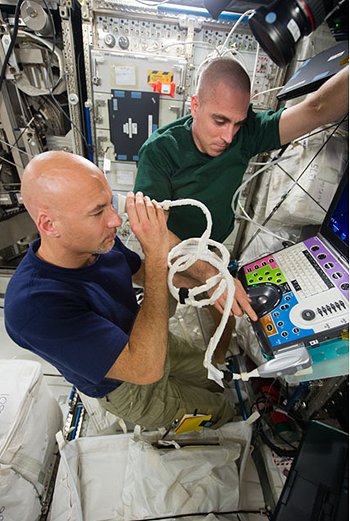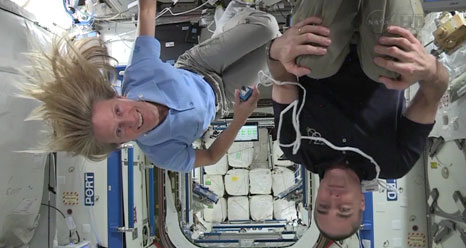.
NASA Television to Air June 24 Space Station Spacewalk
WASHINGTON -- NASA Television will provide live coverage when two members of the Expedition 36 crew venture outside the International Space Station on Monday, June 24. The pair will conduct a six-hour spacewalk in preparation for the addition of a new Russian module later this year.
NASA TV coverage of the spacewalk by Russian flight engineers Fyodor Yurchikhin and Alexander Misurkin will begin at 9 a.m. EDT. Yurchikin and Misurkin will begin the spacewalk about 9:35 a.m. when they open the hatch to the space station's Pirs docking compartment and float outside.
They will replace a fluid flow control panel on the station's Zarya module and install clamps for future power cables as an early step toward swapping the Pirs airlock with a new multipurpose laboratory module. The Russian Federal Space Agency plans to launch a combination research facility, airlock and docking port late this year on a Proton rocket.
Yurchikhin and Misurkin also will retrieve several science experiments on the outside of the Zvezda service module.
The spacewalk will be the 169th in support of space station assembly and maintenance, the sixth for Yurchikhin and the first for Misurkin. Yurchikhin will wear an Orlan-MK spacesuit with red stripes while Misurkin will wear a suit with blue stripes. Both spacewalkers will be equipped with NASA helmet cameras to provide close-up views of their work.
This is the second of up to six Russian spacewalks planned for this year. Two U.S. spacewalks by NASA's Chris Cassidy and Luca Parmitano of the European Space Agency are scheduled in July.
.

The ocular ultrasound being performed aboard the International Space Station is an innovation similar to ones that can result from awards granted via the Small Business Innovation Research Program at NASA. (NASA)
.
For small businesses, learning how to interact with and win contracts for government agencies like NASA can lead to big things. The same is true in reverse -- these innovative compact companies have large potential to meet NASA's goals for the International Space Station (ISS). In an effort to bring out new scientific advancements to support the agency's technological needs, NASA selected several small high-technology companies to enter into negotiations for contract awards through the Small Business Innovation Research (SBIR) Program.
SBIR is a competitive, awards-based program that encourages U.S. small businesses to engage in federal research and development and bring new technologies to the global marketplace. It enables businesses to explore innovative ideas and potentially profit from new commercial products and services. The SBIR award system provides qualified small businesses with opportunities to propose unique ideas that meet specific research and development needs of the federal government.
Among the 2012 Phase 1 awardees, the International Space Station Program Utilization Category for Technology awards were presented to:
Nano-structures Enhanced Novel Composite Electrode Material for Batteries, proposed by Scientic Inc. of Huntsville, Ala., integrates advanced nanotechnology with energy storage technology to develop advanced cathode materials for use in Lithium-ion batteries, while maintaining a high level of safety, stability and cycle life. Potential applications for this technology cover a wide span of uses in the aerospace industry and the automotive industry, as well as being adaptable for use in power grids for advanced energy storage solutions.
Passive Devices for Advanced Fluid Management Aboard Spacecraft, proposed by IRPI LLC of Eagle Creek. Ore., addresses the acute challenges faced by designers of fluid systems for spacecraft because of the persistently unfamiliar and unforgiving low-gravity environment. The new passive phase separating components to be designed and developed during Phase 1 can be exploited across a variety of spacecraft fluids systems to markedly increase system reliability and performance. They may also be employed in all liquid systems throughout the spacecraft. Terrestrial applications are identified and pursued as part of broader commercial objectives later in Phases 1 and 2. Applications of this design approach to routine microfluidic flows relating to fuel delivery and biomedical drug delivery represent significant growth opportunities.
On-Orbit Validation System for Space Structure Composite Actuators, proposed by Extreme Diagnostics Inc. in Boulder, Colo., delivers an in-orbit validation system that provides performance and durability data for macro fiber composite active piezocomposite materials operating in the space environment aboard a future Materials International Space Station Experiment platform. Non-NASA commercial applications include Homeland Security structural analysis, civil structures, land and marine structures, medical devices, military structures and many others.
NASA also had updates to the previous 2011 Phase 2 awards as part of this recent release. Those awards are:
Deployable Space System's (DSS) Cost-Effective ISS Space-Environment Technology Validation of Advanced Roll-Out Solar Array (ROSA), proposed by DSS of Goleta, Calif., will enable future exploration missions through ultra-high power solar arrays, comprising lightweight designs with compact stowage and significant affordability. The technology is particularly suited for missions that require game-changing performance in terms of affordability, ultra-lightweight and compact stowage volume. There is tremendous dual-use, non-space commercial private-sector applicability including fixed-ground and deployable/retractable mobile-ground based systems.
Dead-Ended Passive Electrolyzer with Elimination of Vapor/Liquid Separation for Life Support Oxygen, proposed by Giner Inc. of Newton, Mass., has the overall technical objective to demonstrate the ability of the water management membrane-based static vapor feed electrolyzer to generate enough low-moisture content oxygen to support five astronauts. The commercial application possibilities are in life-support oxygen, energy storage, non-terrestrial habitats and space stations, satellites and high altitude aircraft.
Remotely Controlled Mixers for Light Microscopy Module (LMM) Colloid Samples, proposed by Techshot Inc. of Greenville, Ind., will use Colloid Specialty Cell Systems (C-SPECS) devices to offer important new technologies needed for in-orbit analysis, as well as the chance to leverage new scientific payloads using the U.S. portion of the space station. This part of the station has been designated by Congress as a National Laboratory, and holds great potential for a broad spectrum of researchers who are eager to take advantage of its unique scientific research facilities.
ISS Additive Manufacturing Facility (AMF) for On-Demand Fabrication in Space, proposed by Made in Space Inc. of Wilmington, Del., plans to provide the ability to manufacture components on demand in order to fix or replace broken parts on the space station. This 3-D printer will also have the ability to upgrade and maintain space station hardware with manufacturer's parts produced by the AMF to extend the life of critical and non-critical components.
Out of a long list of awardees from the SBIR and Small Business Technology Transfer programs, these additional Phase 2 SBIR selections will continue the successful legacy of the program to bring needed new technologies to NASA and the global marketplace. Michael Gazarik, associate administrator for Space Technology Program at NASA Headquarters in Washington, D.C., stated, "Small businesses are the innovation incubators of the new global technology economy. These companies conduct the early stage research and development that enables future NASA missions in aeronautics, science and exploration."
.

Flight Engineers Karen Nyberg (left) and Chris Cassidy demonstrate weightlessness aboard the International Space Station to students gathered at the Kansas Cosmosphere in Hutchinson, Kan. Credit: NASA TV
Quelle: NASA
4642 Views

